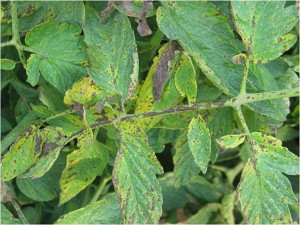What Is It? | Facts in Depth | For the Professional Diagnostician
Tomato Diseases | Bacterial Speck Fact Sheets
Bacterial Speck of Tomato
Identification
Bacterial speck can produce lesions on the leaves, stems and fruit. Foliar symptoms of bacterial spot and speck are identical and can’t be used to reliably identify these diseases. Infections on seedlings are rare and are observed more frequently when spring weather is cool, cloudy and wet. On infected seedlings, small (1/12 inch), black specks with chlorosis appear on the edges and tips of the leaflets. Speck lesions can cause leaf distortion or puckering on young leaflets and severely infected seedlings can be stunted. Lesions on older leaves are dry, necrotic, and chlorotic. As the number of lesions increase they begin to coalesce forming dead areas and eventually cause plant defoliation. Necrotic lesions also appear on the stem.
Fruit lesions are initiated on immature (green) fruit only. Lesions are small (<1/16 inch), black, slightly raised and surrounded by a narrow ring of light green chlorosis. Lesions are superficial and can be easily scraped off the fruit surface with a fingernail.



Pathogen Biology
Infections originate from infested seed, soil or crop debris. Volunteer tomato plants and contaminated equipment or tools can also be a source of these bacteria. Bacteria enter the plant through natural openings, such as stomata or hydathodes, or through wounded tissue. In the greenhouse, high plant density and humidity and warm temperatures provide optimal growth conditions for these bacteria and overhead irrigation contributes to spread. In the field, bacteria are spread through splashing water, wind-driven rain, and overhead irrigation water. Plants are more susceptible to infection after a wounding event such as a hail storm or plant maintenance operation (i.e. pruning, cultivation, pesticide applications with high-pressure sprayers).

Disease Cycle for Seed-borne Bacterial Diseases of Tomato
Favorable Environmental Conditions
Optimal conditions for bacterial speck are high moisture, high relative humidity (≥ 80%) and cool temperatures (64-75°F). The pathogen is inhibited during periods of high temperatures.
Often Confused With
- Bacterial Spot – Look for large crusty lesions on the fruit with no light green halo as indicators of bacterial spot.
- Early Blight – Look for lesions with concentric rings and chlorosis as indicators of early blight.

Scouting Notes
The pathogen is active from the time of plant emergence through to harvest. Because foliar symptoms of bacterial spot and bacterial speck are identical, fruit symptoms should be used to distinguish between the two diseases. Bacterial speck disease progression is slowed during hot weather. Plants in the field should be monitored weekly and symptomatic plant tissue should be sampled and submitted for plant disease diagnosis.
Thresholds
No thresholds have been established for this disease however tolerance is low due to marketability issues.
Management Notes
Bacterial speck can be adequately managed in the field if preventative strategies are implemented early in the season. Fruit lesions can only be initiated on immature fruit so management strategies used prior to fruiting are most beneficial and cost effective.
- Start with clean seed – Purchase certified, disease-free seed or sanitize seed with hot water , sodium hypochlorite (bleach) or hydrochloric acid. Here is a link to The Ohio State University Extension Fact Sheet for Hot Water and Chlorine Treatment of Vegetable Seeds to Eradicate Bacterial Plant Pathogens.
- Start with clean transplants – Scout plants daily and destroy plants once a plant disease diagnostic laboratory has confirmed the disease. Apply one or two preventative copper fungicide applications and one application of streptomycin to the seedlings before transplanting them into the field.
- Start with clean equipment and tools – Clean and disinfect all tools and farm equipment prior to working with the transplants or plants. Good sanitation practices are important to prevent contamination and cross contamination of plants by the bacterial speck pathogen.
- Start with a clean field – The bacterial speck pathogen can survive in the field as long as there is infected crop debris present. Rotate with a non-host crop before re-planting the field with tomato. Avoid rotations with crops in the same family as tomato (pepper, eggplant and tobacco) for 3-4 years. Plant into a field free of volunteer tomato plants.
- Avoid early plantings – Delay planting in springs that are cool and wet as these environmental conditions favor the bacterial speck pathogen.
- Use best cultural practices – Use management strategies that maintain reduced-stress growing conditions. Provide plants with adequate but not excessive nitrogen, improve the organic matter content of the soil through the use of composted green or animal waste or cover crops, avoid overhead irrigation if possible and avoid performing crop maintenance operations while plants are wet.
- Use crop protectants – Field applications of copper fungicides, applied early and often, may slow bacterial speck development on fruit. Copper sprays are not needed when temperatures are above 80°F as the pathogen is inhibited at high temperatures.
